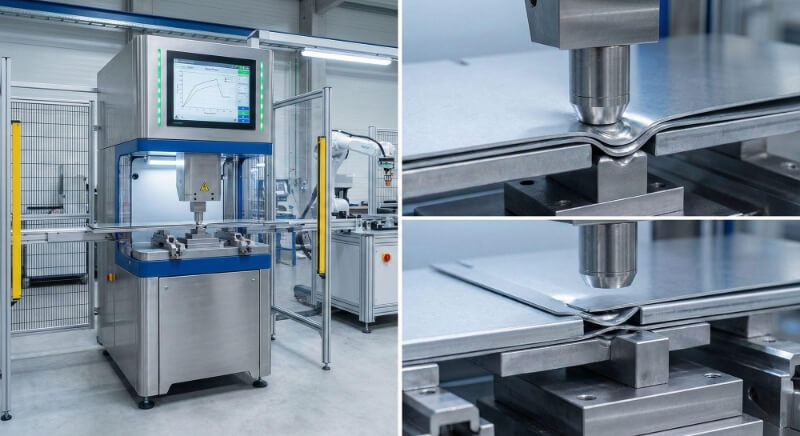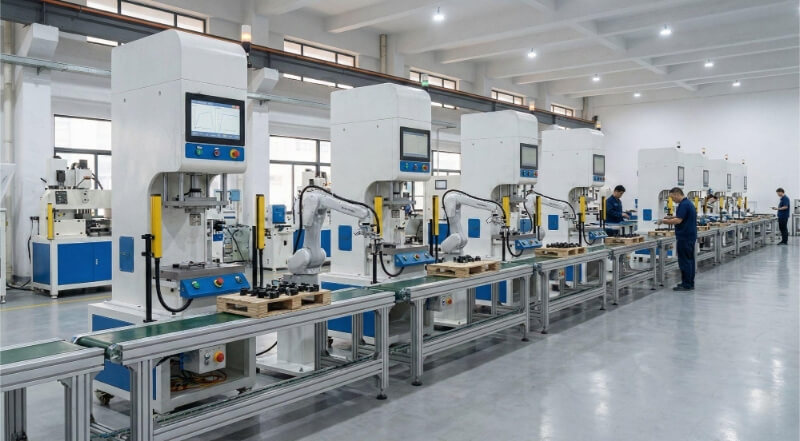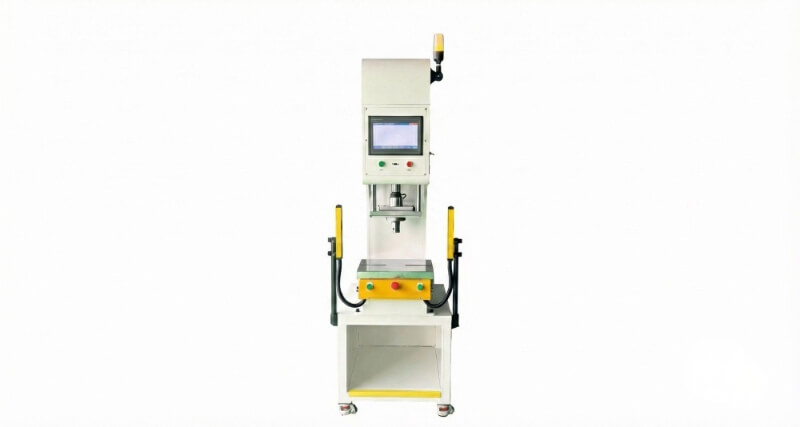While our laser cutting machines hum and buzz, we discuss another unique technology daily. Have you ever thought about the capabilities of water in manufacturing? I’m going to take you into the fascinating world of waterjet-cutting.
Waterjet cutting involves a high-pressure stream of water that is sometimes mixed with abrasive materials to cut through different materials. This method is environmentally friendly, versatile, and produces a smooth surface, making it popular in manufacturing.
Intrigued? Stay with us, and you will see why this might be a big deal for businesses such as ours.
The Science Behind Waterjet Cutting
The core of waterjet cutting uses a high-pressure liquid stream to cut material. We can add abrasive substances to increase the cutting power. What makes the water stream so powerful that it can cut through thick metals easily?
High-Pressure Water Physics: Harnessing Force
In its normal state, water is pliable and gentle. Under extreme pressure, water transforms into a potent cutting tool. Here’s how it works:
Particle acceleration: Increasing the water pressure gives particles tremendous kinetic energy. They move incredibly fast. When the stream passes through a narrow nozzle, it becomes concentrated.
Jet speed: The waterjet can reach rates as high as Mach 3. Imagine the force of three times the sound speed of water!
No heat generation: Waterjet cutting is unlike other cutting methods that rely on heating. Cold cutting ensures that heat or thermal distortion does not affect the material.
Material Separation Mechanics: Cut Through Like Butter
The mechanics of material separation activate when the high-speed water jet strikes the fabric. This is how it works.
Erosive Cut: If you have ever seen a canyon carved out by a river, you’ve experienced erosion. This process is greatly accelerated in waterjet cutting. The waterjet “washes” away the material on a microscopic scale.
Abrasive enhancement: Water alone may be insufficient for more complex materials. In this situation, we can use abrasives like garnet and sand. They act as “teeth,” enhancing the cutting power of the jet when mixed with water. The water speeds up the abrasive particle, which then hits the material so hard that it breaks.
Precision with Minimal Kerf: The waterjet produces a highly narrow cut often called the “kerf.” The waterjet makes a tiny cut, often called the “kerf.” The speed and size of the jet determine the precision of the amount.
Pure vs. Abrasive Waterjet Cutting
Here are the two main types of waterjet cutting: Abrasive Waterjet and Pure Waterjet. The two methods use high-pressure water to cut materials. However, their mechanics and applications are different.
Pure Waterjet cutting: When simplicity meets precision
As the name implies, pure waterjet cutting uses only water. The cutting process solely depends on water’s kinetic power without any additives. What you need to know is:
High-Speed Stream: Water pressure reaches incredible levels when using waterjet cutting. It’s not uncommon for it to exceed 60,000 PSI. The pressurized water then passes through a fine nozzle to become a high-speed jet capable of precise cuts.
Best For Soft Materials: Despite its power, pure waterjet is best for soft materials. Rubber, foam, fabrics, and food products are all examples of soft materials. It would struggle to work with materials like metal and stone without abrasives.
Neat and Clean: One of the most significant advantages of waterjet cutting pure is its clean finish. The cut is usually smooth, and minimal post-processing is required.
Abrasive waterjet cutting: Cutting through the most challenging materials.
Abrasive Waterjet Cutting is the solution for cutting through more rigid materials in Shengen. What makes it different?
Abrasive Advantage: The process begins similarly to waterjet cutting, but an abrasive substance, such as garnet or aluminum oxide, is added to the stream of water. The combination of water and abrasive materials significantly increases the cutting power.
Cutting Hard Materials: Metals, ceramics, and glass do not match the abrasive cutting water jet. The abrasive particle acts like a sandblaster and erodes the material on a microscopic scale.
Versatility: Abrasive waterjet cut is not limited to hard materials. Waterjet cutting is versatile and can be used on softer materials as well.
Unraveling the Core Components of the Waterjet Machine
Like any engineering marvel, a waterjet machine is more than the sum of its components. Each component is crucial to ensuring precision and efficiency.
High-Pressure Pump: The Powerhouse
The heart of any waterjet machine is its high-pressure pump. The high-pressure pump is what gives water its cutting ability.
Generation of Pressure: The pump’s primary function is to pressurize water to incredible levels. This can be up to 60,000 PSI.
Consistent flow: Precision in waterjet cutting depends on a steady, uninterrupted stream. This is achieved by the pump maintaining a constant pressurized output.
Cutting head: The Precision Tool
The cutting head transforms water into a powerful cutting jet.
Nozzle design: The nozzle of the cutting head is designed precisely to direct high-pressure water onto the material. The size and shape of the nozzle are crucial in determining how accurate and clean the cut will be.
Jewel orifice: The nozzle often contains a jewel orifice that focuses and intensifies the water stream.
Abrasive delivery system: amplifying the cut
The abrasive Delivery System is an essential system for abrasive cutting with waterjet.
Hopper storage: This system usually starts with a large hopper that stores abrasive materials like garnet and aluminum oxide.
Measuring: The system measures the correct amount of abrasive while pushing the water toward the cutting head. It then mixes it with water to produce the cutting stream.
Motion Control: Guidance the Cut
Precision is not just about power. It’s also about control. Motion control ensures the cutting stream is accurately moving over the material.
Computer-Aided Design: Modern waterjets are often integrated with CAD software, allowing complex designs to be easily programmed and executed.
Synchronized Motion: This system controls the X, Y, and sometimes Z axes to ensure synchronized movements for depth, width, and height.
From selection to precision: The role of abrasives in waterjet cutting
The abrasives are a crucial part of waterjet cutting. They transform water’s power into something to be feared. Waterjet cutting is powerful, but the abrasives give it its edge. This is especially true when cutting more rigid materials.
Abrasives used in everyday life: more than just sand
Contrary to popular belief, not all sand is created equal. Certain abrasive materials are recognized for their superior cutting abilities over time.
Garnet: Garnet is the most common abrasive. It’s a natural mineral that is inert and perfect for cutting glass, metals, etc. Waterjet cutting is made possible by its sharp edges and high hardness.
Aluminum Oxide: It is another popular option, especially regarding more challenging materials. Aluminum oxide, a highly hardened synthetic material, is ideal for cutting ceramics and superalloys.
Silica sand: Although silica is less popular than garnet and aluminum oxide due to concerns about silicosis, it’s still used in some applications.
Staurolite and Olvine are alternatives to garnet for specific applications.
How to choose the suitable abrasive for different materials
It’s not a matter of playing eeny-meeny-miny-moe. It’s science, and we at Shengen respect it.
Material hardness: More difficult materials need abrasives of greater hardness. While garnet is ideal for metals, glass, and ceramics, aluminum oxide may be the best superalloy choice.
Finish quality: The choice of abrasive will also influence the final finish. Garnet is an excellent example of an abrasive that can provide a smoother finish than other abrasives.
Cutting speed: Some abrasives are faster than others. When speed is a factor, choosing a suitable abrasive can be crucial.
Cost considerations: We at Shengen understand the importance of quality while ensuring cost efficiency. The cost of the abrasive material can influence the selection of an abrasive.
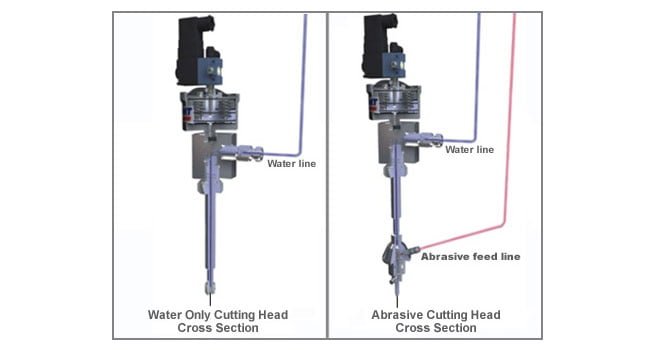
Waterjet Cutting Advantages
Waterjet cutting is a manufacturing marvel, combining precision, versatility, and environmental awareness. What makes this method unique? We’ll explore the many advantages of waterjet-cutting.
The Art of the Perfect Cut: Precision and Accuracy
Waterjet cutting is not just about brute strength; it’s a form of art that ensures unparalleled precision.
Accuracy at the Micron Level: We can achieve up to 0.005-inch accuracy using high-pressure water streams. This is thinner than a hair!
Smooth edges: Due to the constant and controlled flow, the edge of the materials cut with waterjet is often soft and free of burrs, reducing or eliminating the need for secondary finishes.
Versatility – One tool, multiple solutions
Waterjet cutting’s versatility is one of its most notable features. This means that Shengen can meet a wide range of customer needs.
All Around: Waterjet cutting can handle various materials, including metals such as steel and aluminum, rubber, glass, and even stone.
Thickness Doesn’t Matter: Waterjet cutting is not discriminatory. Its efficacy remains consistent.
Minimal Heat Affected Zones: Staying Cool
Waterjet cutting is a cutting method that does not produce excessive heat.
No thermal stress: The materials do not experience thermal stress since it is a cold-cutting method. It means that the edges of the fabric will not warp, distort, or become more arduous.
Benefits for Materials with Sensitive Properties: Materials sensitive to high temperatures, such as certain metals and plastics, can still be cut without affecting their properties.
Crafting with Consciousness: Environmental Benefits
We are passionate about our planet at Shengen. Waterjet cutting is in line with our eco-friendly philosophy.
Water Recyclage: Modern waterjet machines often come with closed-loop systems. This means that water is recycled and used again, reducing waste.
No harmful by-products: The cutting process does not produce toxic gases or fumes. With the right equipment for abrasive recycling, used abrasive is also recyclable, reducing the environmental impact.
Less Material Wastage: Due to its precision and accuracy, waterjet cutting allows for maximum material usage, which results in less waste.
Waterjet cutting: Facing challenges head-on.
To make an informed decision, knowing the benefits and limitations is essential. Waterjet cutting has many benefits but also presents unique challenges. Let’s look at the obstacles that waterjet cutting faces.
Thickness limitations: How deep can you go?
Waterjet cutting is undeniably versatile but has limitations in efficiently cutting specific thicknesses.
Diminishing returns: While waterjets can cut through thick materials, their efficiency and speed decrease as the thickness increases. Waterjets can cut through 2-inch plates of steel with ease, but a 12-inch dish may be painfully slow and inaccurate.
Jet dispersion: As the jet penetrates further, it tends towards distribution, which can affect the precision of the cut, especially when the thickness is more excellent.
Material Constraints – Not All Materials Fit
You can use waterjet cutting on many materials, but some may be more suitable for the technique.
Brittleness Issues: Extremely brittle material can be problematic. Even if you don’t use abrasives, they may chip or crack from the force of water.
Composite Material: Some materials with layered compositions, particularly those with many layers, may delaminate when cut using waterjets.
Precision over Pace: Speed considerations
Although waterjet cutting is exact, it can sometimes be slow.
Depth delays: Compared with laser cutting techniques for specific materials and thicknesses, the deeper the material is, the slower it will cut.
Intricate Design: Waterjet cutting is capable of producing highly detailed cuts. However, the more complex the design, the longer it takes. The jet must slow down to achieve the accuracy of the tight corners and intricate patterns.
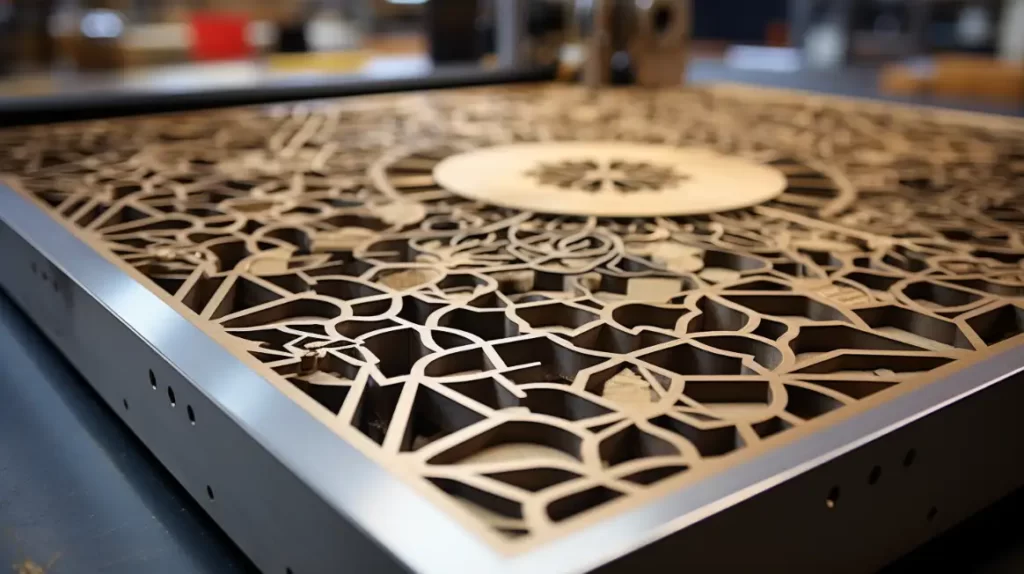
Safety is our top priority in waterjet cutting.
Safety becomes more critical as we use water at incredible pressures for waterjet cutting. The people at Shengen are more important than the product.
Protective equipment: the first line of defense
While waterjet cutting is mesmerizing, it involves high pressures, abrasive material, and fast-moving parts. Personal protective equipment is essential.
Safety goggles: The eyes are particularly vulnerable. Safety goggles are designed to protect your eyes from any accidental splashes and flying abrasive materials.
Ear Protect: The noise produced by high-pressure pumping and the cutting process may harm your hearing. It is essential to wear earplugs or earmuffs.
Protective Clothing and Gloves: Wearing gloves and protective clothing with long sleeves is essential to protect against accidental splashes of abrasives or contact.
Safety Shoes: Due to the variety of tools and materials, you must have a pair of safety footwear with toe protection.
Machine maintenance and checks: the heartbeat of safety
Every machine has its rhythm or heartbeat. It is crucial to maintain this steady rhythm.
Routine Inspecting: At Shengen, we perform regular inspections on our waterjet machine. It is vital to ensure that all parts are working correctly and there are no visible signs of damage or wear.
Emergency shut-offs: Each machine comes with emergency shut-off switches. If there’s an anomaly, you can stop the device instantly.
Operator training: A machine can only be as safe as the operator. A comprehensive training program ensures that the person at the controls knows the device well and can react quickly in unexpected situations.
Respect and not Neglect: Handling Abrasives
Abrasives are crucial, but we need to handle them with care.
Safe Storage: Abrasives must be stored in a cool, dry place, away from reactive substances and excessive moisture.
Handling Abrasives with Care: Protective equipment such as gloves and masks is essential to avoid any inhalation of abrasives or direct contact.
Disposal Protocols: At Shengen, we ensure that used abrasives are disposed of responsibly. We pledge to recycle as much as possible and ensure that the abrasives do not harm the environment.
Selecting the suitable material for waterjet cutting
Waterjet cutting is versatile, but your chosen material can dramatically impact the result. Understanding which materials best suit waterjet can differentiate between mediocrity and perfection.
Metals and Alloys – The Sturdy Partner
Metals are often at the top of people’s lists regarding materials that are difficult to cut. A water jet can cut metals.
Steel and Stainless Steel: Steel variants can be cut accurately without deformations caused by heat or other changes to properties.
Aluminum: Aluminum is lightweight and widely used in many industries. It cuts easily, leaving no burrs.
Waterjets can easily cut Titanium and Brass without causing thermal changes.
The Delicate Dance of Glass and Ceramics
With their inherent fragility, glass and ceramics can pose a challenge. Waterjet cutting can handle them with ease.
Tempered glass: Tempered glass is a notoriously tricky customer. Waterjets can cut intricate designs without breaking them.
Tiles and Ceramics: Waterjet cutting allows for precision in ceramics, from decorative pieces to industrial uses. It can even create intricate patterns and designs.
Composites & Laminates – The Complex Choreography
Waterjets can handle the layered nature and complexity of composites, laminates, and other materials.
Composites of Carbon Fiber: These composites are used extensively in aerospace and automotive. They can be cut easily without delamination or fraying.
Laminated Material: Waterjets can easily be cut through laminated sheets or glass.
Textiles & Foam: The Gentle Embrace
Textiles and foams are soft, pliable, and intricate. They require a delicate touch.
Textiles and Fabrics: Waterjet cutting is the best way to cut industrial materials and delicate fabrics. The edges remain smooth.
Foams: Can be used for insulation, packaging, or cushioning. Waterjets can shape the material into precise forms and thicknesses without compression or deformation.
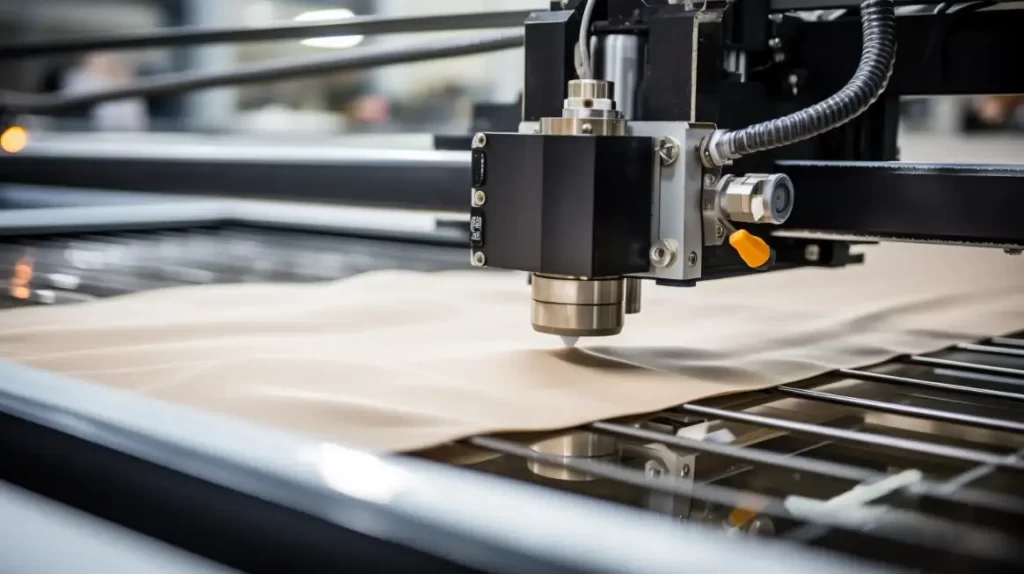
What Industries are in Focus? Industry Focus
The applications of this technology, from the sky to the worlds of fashion and everything in between, are vast and varied. With its unique capabilities, waterjet cutting serves a variety of industries and has proven its worth time and time again.
Aerospace and Automobile: Flying High and Cruising Smoothly
Precision, strength, and dependability are the hallmarks of aerospace and automobile. Here, waterjet cutting is a natural fit.
Aerospace: The components for aircraft, space vehicles, satellites, and other aerospace devices require high precision. Cold waterjet cutting doesn’t alter material properties, making it ideal for complex aerospace components.
Automotive: Waterjet cutting is a precision-driven method that can produce mass-produced parts and custom car components for luxury brands and everyday vehicles.
Architecture & Construction: Crafting Modern Wonders
Waterjet cutting is crucial in the ever-changing world of construction and architecture.
Architecture: Whether it’s intricate facades, customized tiles, or artistic installation, waterjet cutting allows architects to realize their visions with unmatched precision.
Construction: Complex shapes, robust materials, and tight deadlines are all part of the construction process. Waterjet cutting is a solution for cutting structural beams and decorative elements.
Textiles and Fashion: Tailoring for Perfection
Waterjet cutting is a hero in textiles, fashion, and creativity, where craftsmanship meets creativity.
Textiles: Using waterjet cutting, you can create intricate patterns, lacework, or even carpets with great detail. With waterjet cutting, the fabric edges remain smooth and unfrayed.
Fashion: Designers searching for avant-garde designs use waterjet cutting to create leather, synthetic fabric, and delicate silks. This adds a modern touch to their collections.
Medical Biotechnology: Care meets precision
Waterjet cutting is an excellent choice for industries where a millimeter difference can be a game changer.
Medical: Orthopedic implants, surgical instruments, and prosthetics require utmost accuracy and clean cuts. The ability of waterjets to work with different materials is a primary reason for their selection.
Biotech: The biotech industry appreciates the precision and versatility that waterjet cutting offers. It is versatile, from crafting lab equipment to cutting delicate membranes.
The Future of Precision Waterjet Technology
Our technology is also evolving, pushing the boundaries of what’s possible. Waterjet technology advancements aren’t just evolutionary. They’re also revolutionary.
Advanced Motion Controls – Dancing with Precision
Waterjet cutting is a dance that relies on precise, calculated, and harmonious movements.
Linear Drives and High-Speed Servos: They have improved the speed and accuracy of waterjets.
Real-Time Feedback Systems: These systems allow our waterjet machines to adjust immediately. This method guarantees that even intricate designs are cut flawlessly.
Nozzle Design Enhancements: Where Magic Happens
There have been significant improvements to the nozzle. It is the center of action.
Nozzles for Taper Compensation: They counter the natural tapering effect of water jet use. They ensure that the top and bottom of the cut have the same profile.
Multiple mini-jets: Instead of a single stream of jets, innovative nozzles deploy multiple mini-jets to offer more intricate cutting abilities, especially for thicker materials.
Automation & Software Developments – The Brain Behind the Brawn
Automaton and software, the industry’s unsung heroes, work behind the scenes to optimize every cut.
Automated Material Handling Systems: These optimize material loading and unloading, decrease manual labor, and boost efficiency.
Advanced Nesting Software: This innovation ensures the optimal placement of components on materials while minimizing waste.
Predictive maintenance tools: The software, with its embedded sensors and advanced algorithms, can predict when a machine may need to be maintained, reducing downtimes and ensuring consistency in performance.
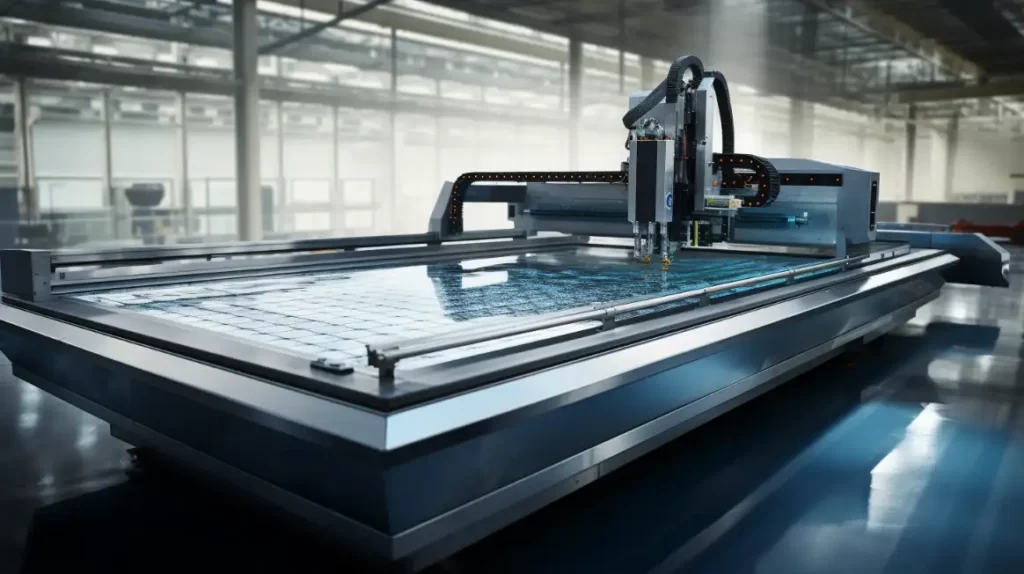
Understanding Waterjet Cutting Costs
Understanding the financial implications of any technology before adopting it is essential. This will ensure that it is technically feasible and economically viable. Before diving into the waterjet-cutting world, it is vital to understand the economic factors that influence its landscape.
Initial investment: Planting the seed of precision
Waterjet cutting is no different. The first step in any journey is to invest.
Machine Purchase: The waterjet machine is at the core of any setup. There is a wide range of pricing based on the features and capabilities. However, ensuring that your chosen device meets industry requirements and fits your specific needs is crucial.
Facility Upgrade: A waterjet machine may require upgrades to the facility, including reinforced flooring, improved power sources, or added safety measures.
Skill Development: A waterjet is only as good as its operator. You can reap the full benefits of your waterjet machine from day one by investing in comprehensive training.
The Daily Dance of Dollars: Operating Costs
The initial investment is the beginning, but the daily operations will shape the story.
Power consumption: Waterjet machines can be very energy intensive, especially if they have potent pumps. You should factor electricity costs into your budget.
Abrasives and Water: Consumables such as water and abrasives are recurring costs. The consumption rate of these consumables varies depending on the type of material and machine efficiency.
Wastewater Management: Proper disposal or recycling of wastewater may be costly, especially in areas with strict environmental regulations.
Longevity and Maintenance: Maintaining the Symphony
Maintenance is vital to the longevity of waterjet machines. It requires the same regular maintenance as a valuable musical instrument.
Routine Inspections and Replacements: Nozzles and seals for high-pressure systems wear out and need replacement. Proper budgeting ensures uninterrupted operations.
Predictive & Preventive Maintenance: Investing in periodic checks to ensure proper maintenance can prevent major breakdowns and save costs over time.
Software Upgrades: Staying up-to-date with the latest software versions ensures optimal operations, enhanced features, and bug fixes.
Waterjet Cutting: The Art of Waterjet Cutting and the Training Requirements
Waterjet cutting is no different. It requires skill, training, and finesse. Waterjet cutting is not just about materials and machines; it’s also about developing your skills and mastering this art.
Essential Operation: Laying the foundation
Each master started as a novice. Basic operation training lays the foundation for waterjet cutting.
Understanding Machine: Familiarizing yourself with machine components is the first step, from the high-pressure pumps to the cutting heads. Understanding the role of each element is essential to a comprehensive understanding of how the machine works.
Material handling: Each material has its cutting requirements. The basic training introduces the operator to the subtleties of handling different materials and sets the stage for precision cuts.
Familiarity with Software: Modern waterjet machines often come with sophisticated software. We use this software for tasks like nesting and path optimization.
Advanced Techniques & Troubleshooting: Elevating Your Craft
After establishing a solid foundation, it’s time to reach the highest levels of expertise.
Mastering advanced cuts: By diving deeper, operators will learn techniques such as taper compensating, multi-axis machining, and intricate pattern forming.
Efficiency Optimizer: We train operators to optimize various parameters, from water pressure to the flow of abrasive materials. This ensures maximum efficiency and minimum waste.
Troubleshooting mastery: Even the most precise machines can have hiccups. Operators who have received advanced training are better equipped to identify problems, whether they’re minor or significant, and to resolve them quickly.
Maintenance Knowledge: Operators learn more than just how to use the machine. They also gain knowledge of the intricacies involved with maintenance, including predicting issues and understanding wear patterns.
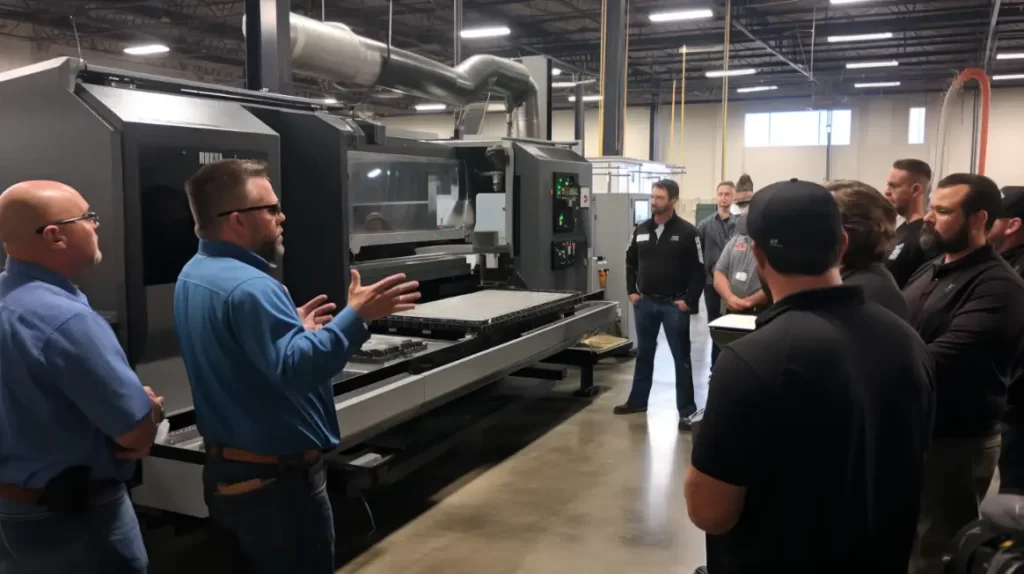
Creating a Greener Future: Environmental and Waste Management with Waterjet Cutting
We are passionate about waterjet cutting and its wonders, but we also care deeply about the environment. When diving into the world of waterjet cutting, you must understand that great technological power also comes with great environmental responsibility.
Water Filtration and Recycling: Preserving Life’s Essence
The water in waterjet cutting is precious. Conserving and managing water for operational reasons and because it impacts the environment is vital.
Closed Loop Systems: This system recirculates and reuses water to reduce water consumption by waterjet machines. These systems filter and refresh the water supply to ensure consistency while minimizing waste.
Filtration Technology: Advanced filtration technologies ensure that water used for cutting is free of contaminants. Filtration ensures the purity of water and efficiency in operation.
Sustainability and Abrasive Disposal: Respecting Every Grain
Waterjet cutting is a crucial process that relies on abrasives. Once they have served their purpose, it is essential to manage them properly.
Responsible disposal: Abrasives can contain residues of materials that are harmful if they are not disposed of correctly. These abrasives won’t hurt the environment by following local regulations and good practices.
Sustainable Source: At Shengen, we prioritize sourcing effective and environmentally sustainable abrasives. This commitment will ensure a lower carbon footprint and a peaceful future in which technology and nature coexist.
Recycling Opportunities: Modern initiatives are exploring recycling used abrasives to turn them into valuable materials for different applications. By adopting these practices, abrasive waste can reduce its environmental impact.
The Cutting edge: Waterjet vs. other cutting techniques
We are waterjet enthusiasts but respect and appreciate the many other cutting methods available. Understanding the strengths and niches of each cutting method is vital to navigating through this maze.
Laser Cutting – The Dance of Light and Metal
Laser cutting is an elegant fusion between light and material. It has distinct advantages and considerations.
Laser Cutting: Lasers offer exceptional precision for cutting thin materials and are ideal for intricate designs.
Heat: This technique can generate heat and alter the material properties or cause heat-affected areas (HAZ). Waterjet cutting, on the other hand, remains calm and prevents thermal distortions.
Material Restrictions: Lasers perform well with some metals or plastics. However, their efficiency drops with thicker materials and reflective surfaces — where waterjets excel.
Plasma cutting: Harnessing the Fourth State of Matter
Plasma cutting is a technique that uses ionized gases at high temperatures to cut through materials.
Cost Efficiency: Waterjet or laser is often more cost-effective for thick materials (primarily metals).
Heat: Similar to laser cutting, the heat generated by plasma can affect material integrity. This pitfall is avoided by waterjet because it’s a cold-cutting technique.
Surface Finish: Plasma may not provide a smooth finish like waterjet. This makes the latter more suitable for applications that require high aesthetic and functional standards.
The Traditional Maestro
Mechanical cutting, which includes milling and sawing techniques, is the master of manufacturing.
Versatility: Mechanical cutting can handle multiple materials with various machines and tools.
Physical contact: Mechanical methods, unlike waterjet, plasma, or laser, involve direct tool-material connections, which can lead to material deformation or wear.
Flexibility: While mechanical methods can be highly versatile, waterjets offer greater flexibility for intricate designs and rapid prototyping.
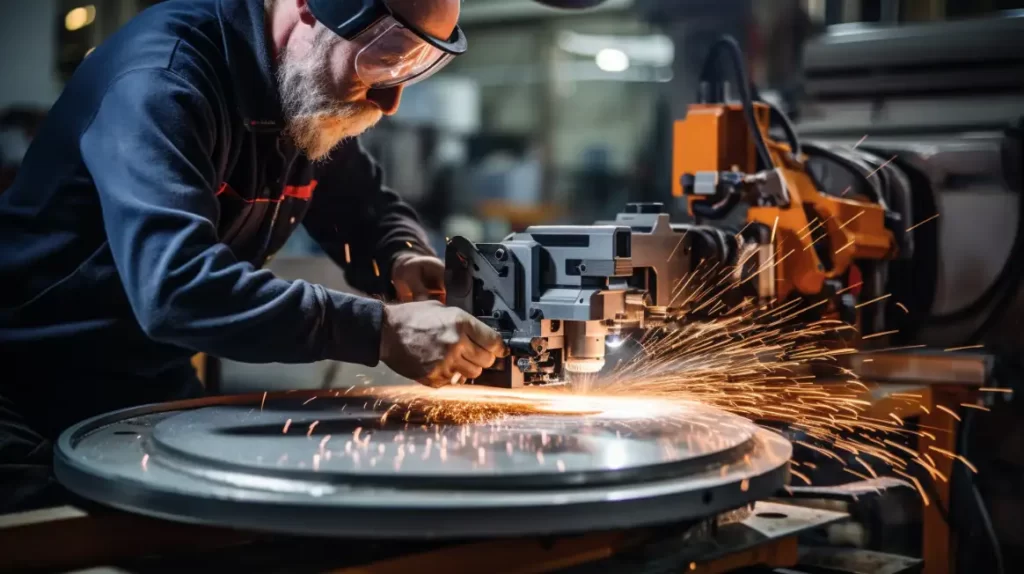
The Future of Waterjet Cutters
While waterjet cutting is already a marvel in modern technology, it’s on the verge of greater possibilities. Let’s imagine the future of waterjet-cutting as we approach tomorrow’s dawn.
Technological Advancements beyond the known
Waterjet cutting is a technology that relies on innovation. Here are some technological advances that we can expect:
Intelligent Machines: AI and machine-learning integration promises machines that can self-optimize and adjust parameters. They will even predict maintenance requirements.
Improved Material Efficiency: Future waterjet systems may use advanced algorithms and sensors to ensure minimal waste and higher precision.
Green Innovations: As sustainability becomes more prominent, we may see waterjets with advanced recycling systems or eco-friendly alternatives to abrasive materials.
New Frontiers in Applications: Expanding applications to new sectors
Waterjet cutting is versatile and finds applications in many sectors.
Space Exploration: As we explore the cosmos further, waterjet cutting could play a crucial role in crafting components for spacecraft due to its precision and versatility.
Biomedical: As the medical field is constantly evolving, waterjet cutting can be used to create intricate prosthetics, surgical instruments, or even specific medical procedures.
Renewable Energy: As the world moves towards green energy, waterjet cutting will shape components for windmills, solar panels, or other renewable infrastructures.
Art and Sculpture: The precision and versatility of the waterjet cut may also find resonance in the art world, allowing artists to create intricate designs using various materials.
Case Studies on Waterjet Cutting in Real-World Conditions
Waterjet cutting’s power isn’t just limited to the walls of our factories. It extends into the real world and brings tangible changes and advancement. We’ll explore some of the most inspiring stories about waterjet cutting. We will highlight the challenges and ingenious solutions and how it has transformed industries.
Aviation Ascension: Crafting Perfect Aircraft Components
The challenge:
A leading aerospace company approached us with a problem. The company required intricate components for its newest aircraft model. Traditional cutting methods weren’t suitable because the materials, made of composites, are heat-sensitive.
The Solution
The cold processing feature of waterjet cutting was perfect for this application. We achieved the required precision without creating heat-affected areas, and the production speed exceeded their expectations.
The outcome:
The aircraft model reached new heights with its perfectly crafted parts, literally and metaphorically. Waterjet cutting was a game changer for the company, as it reduced production time and improved component quality.
Modern Architecture Sculpting a Landmark
The challenge:
Unexpected obstacles arose when a renowned architect envisioned constructing a modern building with intricate metal and tempered glass designs—the traditional cutting methods needed to be more precise or left unsightly markings on the materials.
The Solution to
Enter waterjet cutting. Our team worked closely with the architect to translate his vision into reality. Our team’s ability to work with diverse materials, from metals to glasses, ensured every design detail was respected and realized.
The outcome:
Today, the building is a monument to the marriage of architectural genius with waterjet precision. Both visitors and critics have praised the flawless detailing of our building, attributing this to our cutting-edge technology.
Driving Innovation: Automotive Excellence
The challenge:
A large automotive company was looking for a way to create parts for its new luxury model. The traditional methods could have been faster or compromised the material’s properties.
The Solution
The company enlisted Shengen waterjet cutting services to guarantee precision without compromise. Our machines were calibrated to automotive perfection and delivered parts that fit seamlessly into the luxury model.
The outcome:
Our precision parts made the car model a sensation in the industry. Reviews praised its craftsmanship and nodded toward the magic behind waterjet cutting.
Conclusion
For forward-thinking businesses, adopting cutting techniques such as waterjet is a must. Waterjet cutting offers versatility, quality, and efficiency while promoting sustainability. Shengen constantly strives to incorporate the latest technologies and practices to serve our customers better. It’s not enough to follow industry trends but also to set them.
Do you need a reliable sheet metal parts manufacturer? Shengen is the place to go. We specialize in sheet metal laser cutting, bending, surface finish, and sheet metal welding. We place a high priority on establishing trust, maintaining standards of quality, providing competitive prices, and guaranteeing timely delivery. Reach out to Shengen Today and seek help from professionals!
More Resources:
Material considerations for waterjet cutting – Source: Sendcutsend
Costs associated with waterjet cutting – Source: Swaterjet
Hey, I'm Kevin Lee

Lorem ipsum dolor sit amet, consectetur adipiscing elit. Ut elit tellus, luctus nec ullamcorper mattis, pulvinar dapibus leo.
Get in touch

Kevin Lee
I have over ten years of professional experience in sheet metal fabrication, specializing in laser cutting, bending, welding, and surface treatment techniques. As the Technical Director at Shengen, I am committed to solving complex manufacturing challenges and driving innovation and quality in each project.

